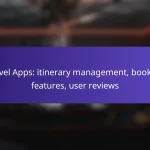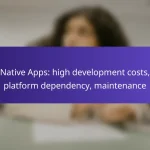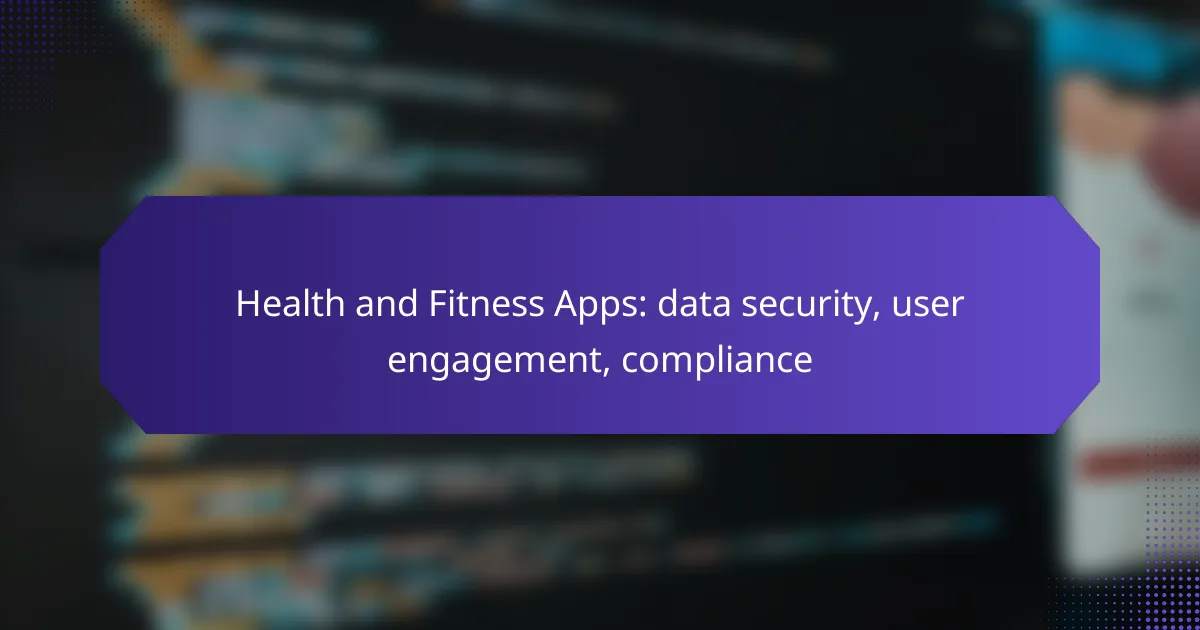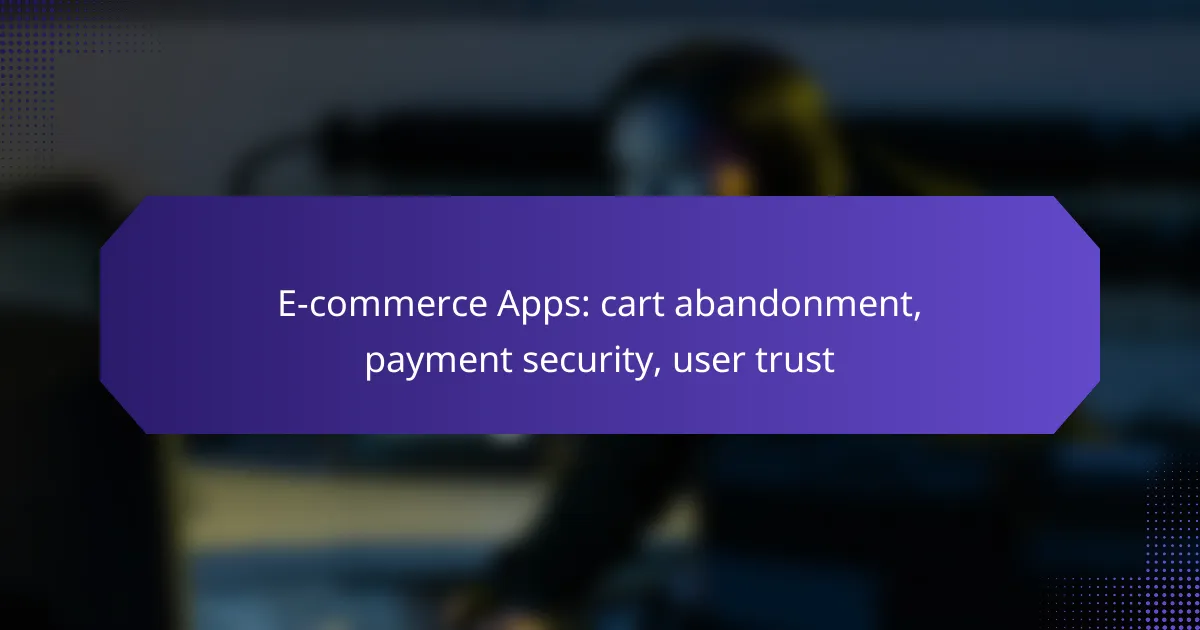The gaming app market is characterized by intense competition, making it challenging for developers to achieve growth and profitability. To succeed, they must not only navigate high user acquisition costs and market saturation but also implement effective monetization strategies while ensuring user retention through personalized experiences and community engagement.
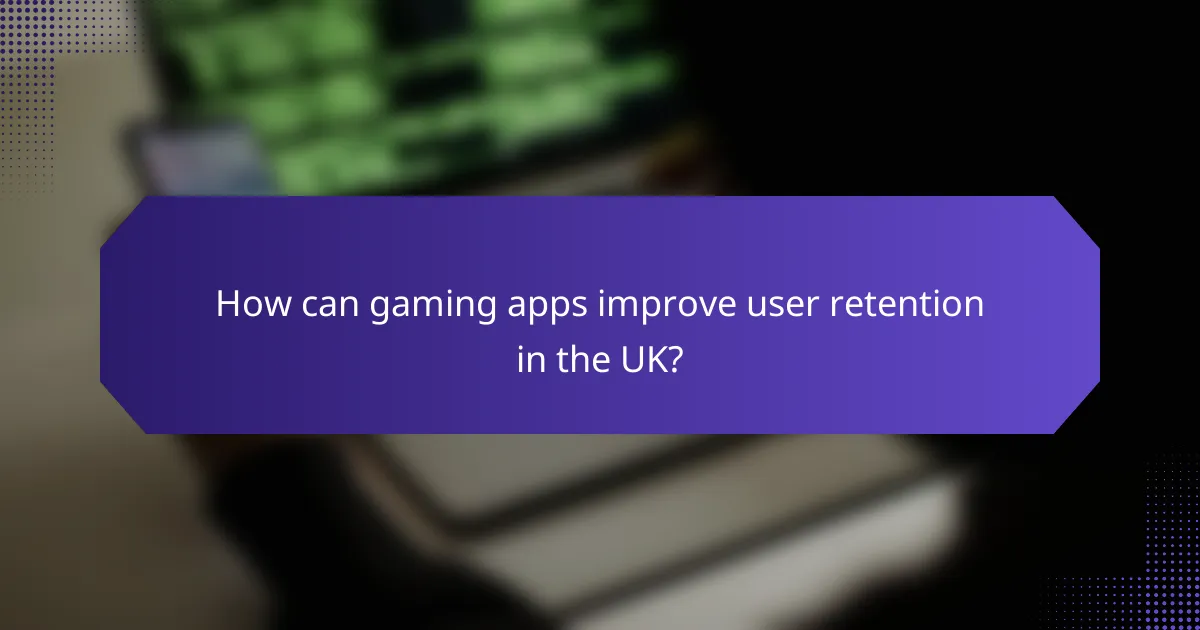
How can gaming apps improve user retention in the UK?
Gaming apps in the UK can enhance user retention by focusing on personalized experiences, community engagement, and regular updates. Implementing effective strategies such as loyalty programs and push notifications can significantly keep players engaged and returning to the app.
Implementing loyalty programs
Loyalty programs reward users for their continued engagement, which can lead to increased retention. Offering in-game currency, exclusive items, or discounts can incentivize players to log in regularly and participate in events.
Consider tiered rewards that provide greater benefits as users progress. This approach encourages players to stay active and invest more time in the game to unlock higher rewards.
Enhancing user experience
A seamless user experience is crucial for retaining players. Focus on intuitive navigation, fast loading times, and visually appealing graphics to keep users engaged. Regularly gather feedback to identify pain points and areas for improvement.
Consider implementing tutorials or onboarding processes that help new users understand game mechanics quickly. This can reduce frustration and enhance overall satisfaction, leading to longer play sessions.
Regular content updates
Frequent content updates keep the game fresh and exciting, encouraging users to return. Introduce new levels, characters, or challenges to maintain interest and provide players with something to look forward to.
Establish a predictable schedule for updates, such as monthly or quarterly releases, to build anticipation among your player base. This consistency can help foster a loyal community around your game.
Utilizing push notifications
Push notifications can effectively remind users of in-game events, promotions, or updates. Use them strategically to re-engage players without overwhelming them, as excessive notifications can lead to app uninstalls.
Personalize notifications based on user behavior, such as reminding players of unfinished quests or upcoming events that match their interests. This tailored approach can significantly improve user retention rates.
Incorporating social features
Integrating social features allows players to connect with friends and share their achievements, enhancing the gaming experience. Features like leaderboards, multiplayer modes, or in-game chat can foster a sense of community.
Encourage users to invite friends by offering rewards for referrals. This not only retains existing players but also attracts new users, expanding your game’s reach and engagement.
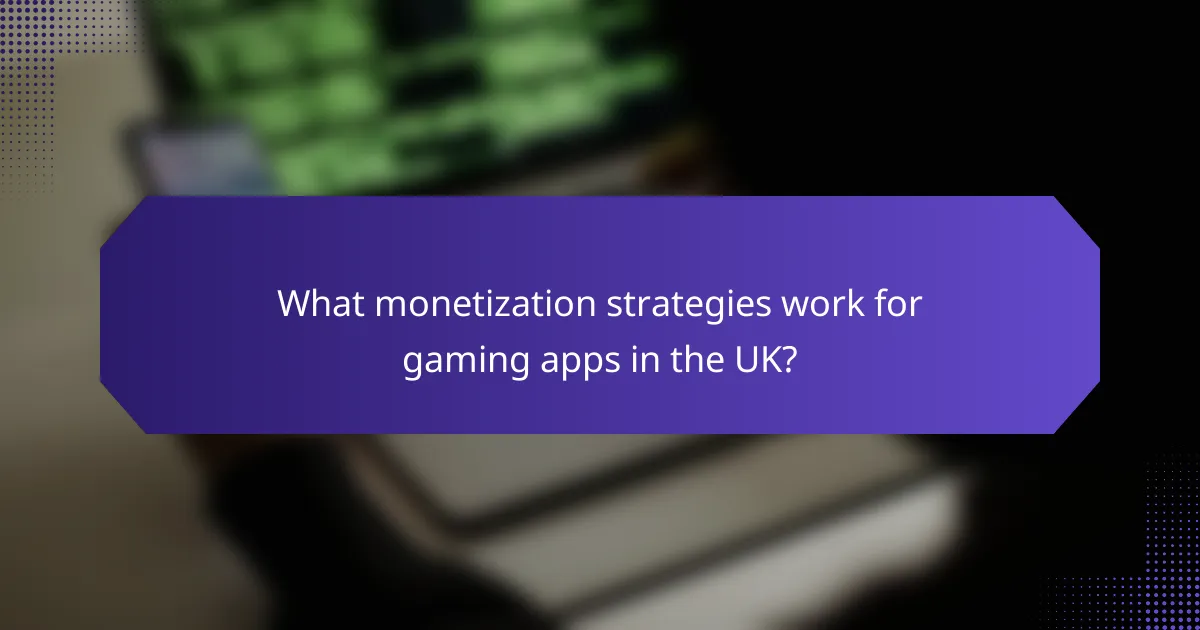
What monetization strategies work for gaming apps in the UK?
In the UK, effective monetization strategies for gaming apps include in-app purchases, subscription models, ad-based revenue, and partnerships with brands. Each method has its own advantages and challenges, and successful developers often combine several strategies to maximize revenue while maintaining user engagement.
In-app purchases
In-app purchases (IAP) allow users to buy virtual goods or enhancements within the game. This model can be highly lucrative, especially for free-to-play games, as it encourages users to spend money on items that enhance their gaming experience.
To optimize IAP, consider offering a range of price points, from low-cost items to premium offerings. It’s essential to balance the game’s economy to avoid frustrating users while still incentivizing purchases. Common pitfalls include making essential items too expensive or creating a pay-to-win scenario that can alienate players.
Subscription models
Subscription models provide users with ongoing access to premium content or features for a recurring fee. This approach can create a steady revenue stream and foster user loyalty, as subscribers often feel more invested in the game.
When implementing a subscription model, consider offering a free trial period to attract users. Pricing should be competitive, typically ranging from a few pounds to around ten pounds per month. Ensure that the value provided justifies the subscription cost to minimize churn rates.
Ad-based revenue
Ad-based revenue involves displaying advertisements within the game, generating income based on impressions or clicks. This model can be effective for free games, allowing developers to monetize users who may not make in-app purchases.
To maximize ad revenue, use a mix of ad types, such as interstitials, rewarded videos, and banners. However, be cautious not to overwhelm users with ads, as excessive interruptions can lead to negative experiences and decreased retention. Aim for a balanced approach that maintains user engagement while generating revenue.
Partnerships with brands
Partnerships with brands can enhance monetization by integrating branded content or promotional events within the game. This strategy not only generates revenue but can also attract new users through brand recognition.
When forming partnerships, choose brands that align with your game’s audience and values. Collaborations can take various forms, such as exclusive in-game items or themed events. Ensure that these partnerships add value to the user experience rather than detracting from it, as poorly executed collaborations can lead to user dissatisfaction.
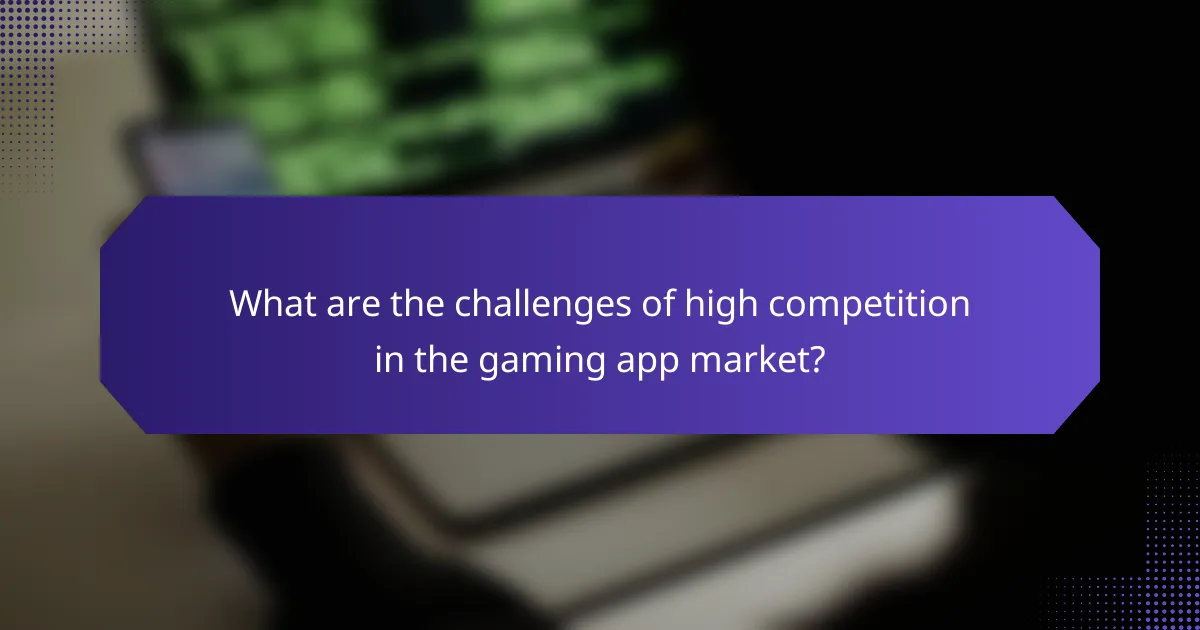
What are the challenges of high competition in the gaming app market?
The gaming app market faces significant challenges due to high competition, which can hinder growth and profitability. Developers must navigate issues like market saturation, high user acquisition costs, and the difficulty of differentiating their products.
Market saturation
Market saturation occurs when the number of gaming apps exceeds the demand from users. This oversupply makes it challenging for new entries to gain visibility and traction. Developers must find innovative ways to capture user interest amidst a sea of similar offerings.
To combat saturation, focusing on niche markets or unique gameplay mechanics can help. For instance, targeting specific demographics or genres can create a loyal user base that is less likely to switch to competitors.
High user acquisition costs
High user acquisition costs are a major hurdle for gaming apps, often requiring substantial investment in marketing and advertising. Costs can vary widely, but many developers report spending several dollars per user, which can quickly add up, especially for smaller studios.
To optimize acquisition costs, developers should consider leveraging organic growth strategies, such as social media marketing and influencer partnerships. Additionally, utilizing data analytics to refine targeting can improve the efficiency of paid campaigns.
Difficulty in standing out
With numerous gaming apps available, standing out in the market is increasingly difficult. Unique branding, engaging gameplay, and effective marketing strategies are essential to capture user attention. Without these elements, even high-quality games may struggle to gain visibility.
Developers should focus on creating compelling narratives and user experiences that resonate with their target audience. Regular updates and community engagement can also foster loyalty and encourage word-of-mouth promotion, which is invaluable in a crowded marketplace.

What criteria should be considered when choosing a gaming app monetization strategy?
When selecting a monetization strategy for a gaming app, consider user demographics, market trends, and competitive analysis. These factors help determine the most effective approach to generate revenue while retaining users.
User demographics
User demographics play a crucial role in shaping your monetization strategy. Understanding the age, gender, location, and spending habits of your target audience can inform whether to use in-app purchases, subscriptions, or ad-based models. For instance, younger audiences may prefer free-to-play models with microtransactions, while older users might be more inclined to pay for premium features.
Gathering demographic data through surveys or analytics tools can help tailor your app’s offerings. For example, if your app attracts a significant number of users from Europe, consider pricing strategies in Euros that reflect local purchasing power.
Market trends
Staying updated on market trends is essential for selecting a successful monetization strategy. Trends such as the rise of subscription services or the popularity of battle passes can influence how users expect to pay for content. For example, many successful games have adopted a seasonal model that encourages ongoing spending through limited-time offers.
Monitoring competitors and industry reports can provide insights into which strategies are currently effective. Adapting to these trends can help your app remain relevant and appealing to users.
Competitive analysis
Conducting a competitive analysis allows you to understand what monetization strategies your competitors are using and how successful they are. Identify key players in your niche and analyze their revenue models, user engagement tactics, and pricing strategies. This can reveal gaps in the market that your app can exploit.
Consider creating a comparison table that highlights different monetization approaches used by competitors, such as ad revenue, in-app purchases, or subscription fees. This will help you identify best practices and potential pitfalls to avoid in your own strategy.
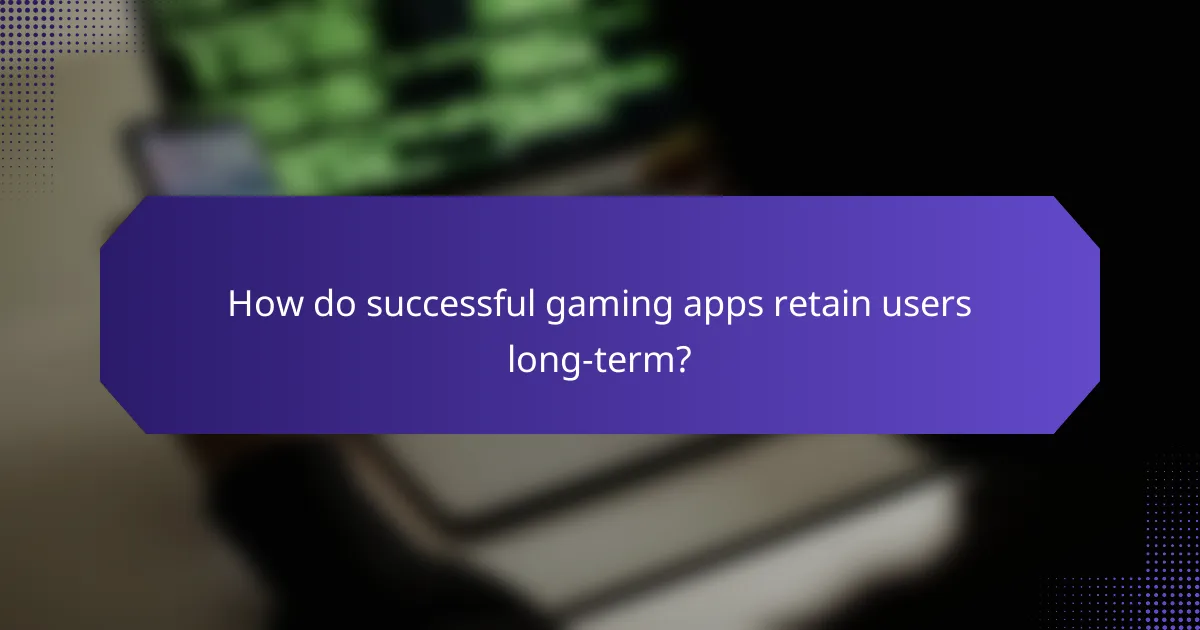
How do successful gaming apps retain users long-term?
Successful gaming apps retain users long-term by fostering a sense of community and continually providing fresh content. These strategies not only keep players engaged but also encourage them to return regularly, enhancing overall user retention.
Engaging community features
Community features such as forums, chat systems, and social media integration create a sense of belonging among players. By allowing users to connect, share experiences, and collaborate, gaming apps can enhance loyalty and encourage word-of-mouth promotion.
Incorporating features like guilds or clans can further strengthen community ties. Players often enjoy the camaraderie and competition that comes from being part of a group, which can lead to increased playtime and investment in the game.
Frequent updates and events
Regular updates and in-game events are crucial for maintaining user interest. These updates can include new levels, characters, or gameplay mechanics that keep the experience fresh and exciting. Seasonal events or limited-time challenges can create urgency and encourage players to log in frequently.
Consider implementing a schedule for updates, such as monthly content drops or weekly events. This predictability can help players anticipate new content, making them more likely to stay engaged over time. Additionally, rewarding players for participation in events can further enhance retention rates.
